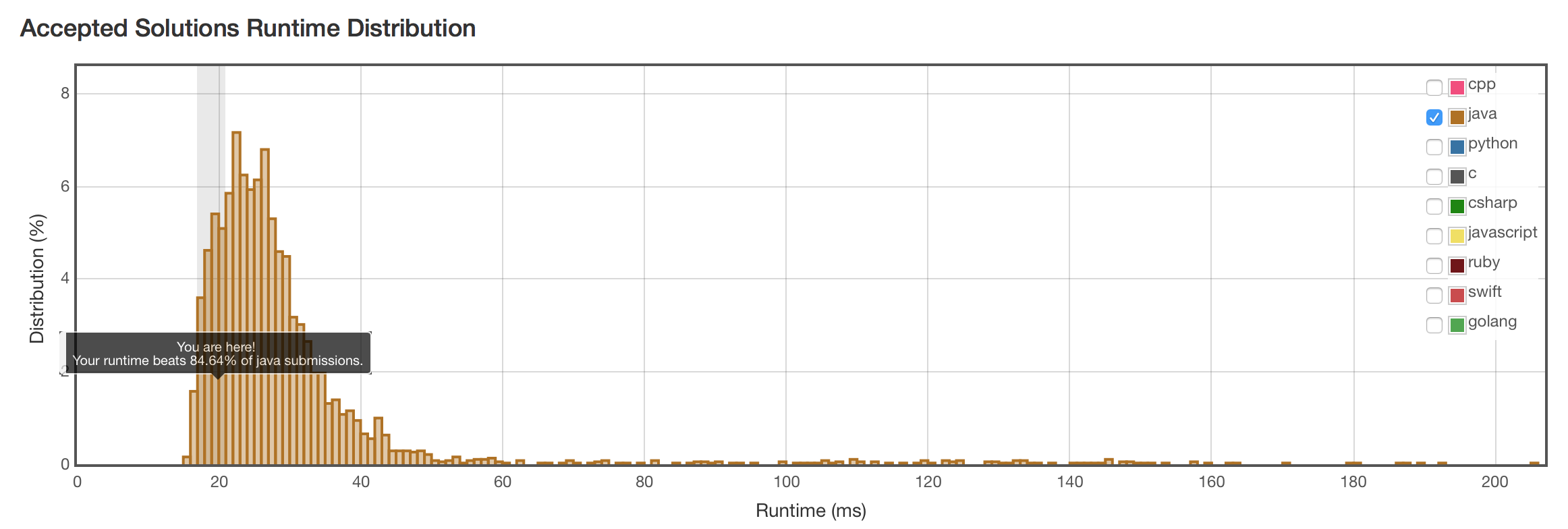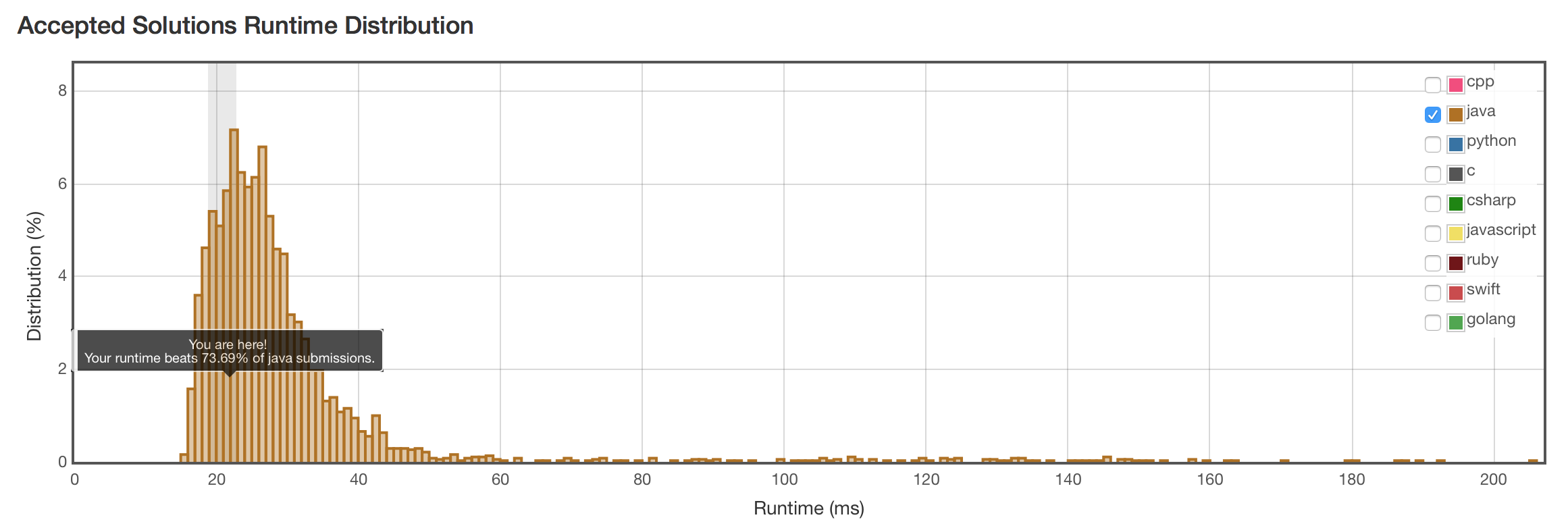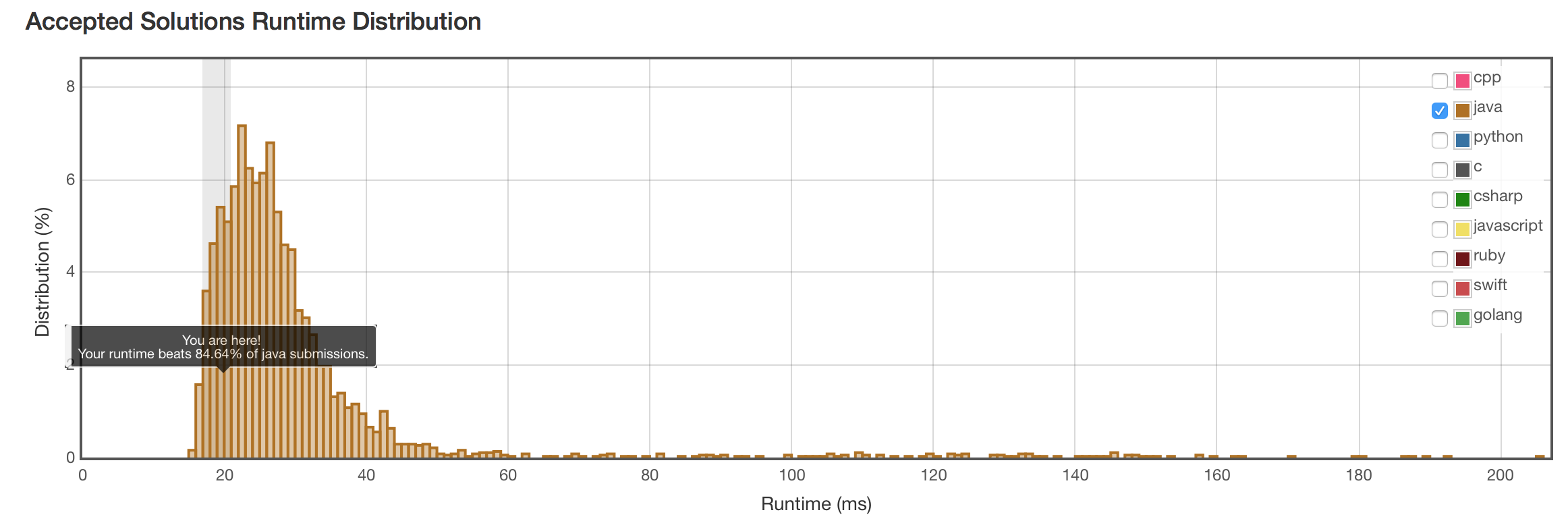主要收获 - 1
规范了 回溯算法 的经典写法。 这是一个非常常用的算法。 需要肌肉记忆。
主要收获 - 2
复习和强化了 排序以后,不重复遍历 的思想。
主要收获 - 3
一个普遍常识是,官方容器List的效率和Array差不太多。这次特意实际做了比较。证实了这种说法。
题目
Given a set of candidate numbers (C) (without duplicates) and a target number (T), find all unique combinations in C where the candidate numbers sums to T.
The same repeated number may be chosen from C unlimited number of times.
Note: All numbers (including target) will be positive integers. The solution set must not contain duplicate combinations. For example, given candidate set [2, 3, 6, 7] and target 7, A solution set is:
[
[7],
[2, 2, 3]
]
暴力递归回溯 \(O(n^n)\)
[8,7,4,3],目标值11。先排序,得到[3,4,7,8]。对数组中的每个数,只要加上历史小于目标值就开下一层递归。
初始累积总和 = 0,
0+3 < 11 >>> [3], 递归面对[3,4,7,8]
0+4 < 11 >>> [4], 递归面对[3,4,7,8]
0+7 < 11 >>> [7], 递归面对[3,4,7,8]
0+8 < 11 >>> [8], 递归面对[3,4,7,8]
注意! 这里虽然先排序了,但并没有利用到排序的所有好处。排序仅仅是用来做剪枝。当找到[4,7]是正确解之后,就不再遍历[4,8]的组合,因为肯定会溢出。但其实排序能带来更大好处。
代码
public class Solution {
public List<List<Integer>> combinationSum(int[] candidates, int target) {
Arrays.sort(candidates);
List<List<Integer>> result = new ArrayList<>();
recursion(new ArrayList<Integer>(), 0, candidates, target, result);
return result;
}
public void recursion(List<Integer> register, int sum, int[] candidates, int target, List<List<Integer>> result) {
for (int i : candidates) {
if (sum + i > target) { break; } // 剪枝
List<Integer> copy = new ArrayList<>(register);
copy.add(i);
if (sum + i == target) {
Collections.sort(copy);
if (! result.contains(copy)) {
result.add(copy);
}
} else {
recursion(copy,sum+i,candidates,target,result);
}
}
}
}
结果
So stupid, but it works.

顺序遍历,不重复 \(O(2^n)\)
因为[8,7,4,3]排序后得到[3,4,7,8]。对于可能的三个结果:[3, 4, 4], [3, 8], [4, 7]。只要遍历的时候加一个指针,坚持不回退取更小的数,就不会得到重复结果。
举例来说,考虑[4,7]。因为第一个数取了4。就不需要再回头取3,得到[4,3,3]和之前的[3,4,4]重复。所以第一个数取了[4]以后,只需要考虑>= 4的数即可。
总的来说,对于[3,4,7,8],我们遍历的顺序如下,
[3],从3开始,肯定有3,可能有4,7,8的所有组合。
[4],从4开始,没有3,肯定有4,可能有7,8的所有组合。
[7],从7开始,没有3,4,肯定有7,可能有8的所有组合。
[8],从8开始,没有3,4,7,只有8的所有组合。
这样一来,减少了迭代的数量,复杂度一下子从全排列的\(O(n^n)\)降到全组合的\(O(2^n)\)。而且得到的结果也不需要去重,当然也不需要去重前的排序。
这是非常典型的循序遍历的例子!
代码
public class Solution {
public List<List<Integer>> combinationSum(int[] candidates, int target) {
Arrays.sort(candidates);
List<List<Integer>> result = new ArrayList<>();
recursion(new ArrayList<Integer>(), 0, candidates, 0, target, result);
return result;
}
public void recursion(List<Integer> register, int sum, int[] candidates, int start, int target, List<List<Integer>> result) {
for (int i = start; i < candidates.length; i++) {
int newSum = sum + candidates[i];
if (newSum > target) { break; }
List<Integer> copy = new ArrayList<>(register);
copy.add(candidates[i]);
if (newSum == target) {
result.add(copy);
} else {
recursion(copy,newSum,candidates,i,target,result);
}
}
}
}
结果
银弹!

尝试用Integer[]替代ArrayList<Integer>提高效率,失败!
结果证明,老老实实用Collection Framework的容器,效率不必折腾Array低。
代码
public class Solution {
public List<List<Integer>> combinationSum(int[] candidates, int target) {
Arrays.sort(candidates);
List<List<Integer>> result = new ArrayList<>();
recursion(new Integer[0], 0, candidates, 0, target, result);
return result;
}
public void recursion(Integer[] register, int sum, int[] candidates, int start, int target, List<List<Integer>> result) {
for (int i = start; i < candidates.length; i++) {
int newSum = sum + candidates[i];
if (newSum > target) { break; }
Integer[] copy = Arrays.copyOf(register,register.length+1);
copy[copy.length-1] = candidates[i];
if (newSum == target) {
result.add(new ArrayList<Integer>(Arrays.asList(copy)));
} else {
recursion(copy,newSum,candidates,i,target,result);
}
}
}
}
结果
反而比老老实实用ArrayList慢。

重点来啦:标准的回溯算法 \(O(2^n)\)
虽然上面的写法都对。思想也是标准的回溯算法。但有个缺点,每次传递累加列表的时候,都不敢直接在当前列表上插入元素。都是拷贝一个新数组。这样需要空间资源增多。执行过程中会产生很多中间列表对象。
List<Integer> copy = new ArrayList<>(register);
copy.add(candidates[i]);
而且这样的写法也没有体现真正 回溯算法 的精髓,就是 回溯。之所以叫回溯,就是说不管对不对,先往这条路走,不对再退回来。
重点细节,看下面代码中的注释。
代码
public class Solution {
public List<List<Integer>> combinationSum(int[] candidates, int target) {
Arrays.sort(candidates);
List<List<Integer>> result = new ArrayList<>();
backtrack(new ArrayList<Integer>(), target, candidates, 0, result);
return result;
}
public void backtrack(List<Integer> temp, int remain, int[] candidates, int start, List<List<Integer>> result) {
if (remain == 0) {
result.add(new ArrayList<Integer>(temp));
return;
}
for (int i = start; i < candidates.length; i++) {
if (remain < candidates[i]) { break; } // 剪枝。当发现某个数太大,后面的更大的数也不用尝试了。
// 回溯算法的精髓就体现在这三行上
temp.add(candidates[i]); // 先插入新元素,递归下去。
backtrack(temp,remain-candidates[i],candidates,i,result);
temp.remove(temp.size()-1); // 递归结束,再删掉元素,继续迭代。
}
}
}
结果
